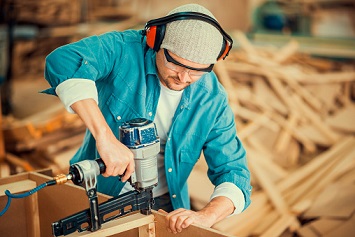Pneumatic nail guns (PNGs) are formidable machines powered by air compressors that with a single trigger activation enable nails to be completely driven into hardwood floors, framing lumber, plywood sheathing, and roof substrates. When used properly, PNGs boost productivity, particularly in home construction. However, the power and speed inherent in these tools have led to many injuries. One study found that 2 out of 5 residential carpenter apprentices experienced a nail gun injury over a 4-year period. Most injuries occur to the hands, and a significant portion of these do not result in hospitalization. However, OSHA and the National Institute for Occupational Safety and Health (NIOSH) report that PNG injuries result in about 37,000 emergency room visits each year.
OSHA has promulgated standards that cover pneumatic tools in general and PNGs specifically. But OSHA’s regulations do not address what is considered the major cause of PNG injuries—the use of PNGs with multishot contact triggers (also called bump triggers, successive triggers, dual-action, touch trip, contact trip, and bottom fire). PNGs with bump triggers are popular in roofing and flooring, which are generally considered safer uses for these PNGs because the work is flat or nearly flat. The higher risk occurs when PNGs are used in vertical construction, such as framing, where workers often need to hold pieces in place while nailing. About two-thirds of PNG injuries occur in framing and sheathing work, note OSHA and NIOSH.
Also, about 1 in 10 nail gun injuries happen to coworkers. This can occur when nails become airborne or when a worker carrying a gun with the trigger squeezed bumps into a coworker. OSHA and NIOSH note that unintentional nail discharges from PNGs can be reduced by using PNGs that have full sequential triggers rather than bump triggers. Their guide provides six steps to PNG safety.
Engineering Controls
Apart from light-duty staplers, most PNGs have engineered parts that protect workers and others. The primary safety feature is at the business end of the gun, where the nail is discharged. This provision is addressed in the only OSHA requirement that applies specifically to PNGs: “All pneumatically driven nailers, staplers, and other similar equipment provided with automatic fastener feed, which operate at more than 100 pounds per square inch [psi] pressure at the tool, shall have a safety device on the muzzle to prevent the tool from ejecting fasteners unless the muzzle is in contact with the work surface.” (29 CFR 1926.302(b)(3))
But OSHA’s standard does not address important variations in how these safety devices function. “All nailers rely on two basic controls: a finger trigger and a contact safety tip located on the nose of the gun,” state OSHA/NIOSH. “Trigger mechanisms can vary based on (1) the order in which the controls are activated and (2) whether the trigger can be held in the squeezed position to discharge multiple nails OR if it must be released and then squeezed again for each individual nail. Combining these variations gives four kinds of triggers.”
- Full sequential trigger. This is the safest type of nail gun trigger. This trigger will only fire a nail when the controls are activated in a specific order. First, the safety contact tip must be pushed against the workpiece. Second, the user squeezes the trigger to discharge a nail. Both the safety contact tip and the trigger must be released and activated in that order to fire a second nail. Nails cannot be bump fired. The full sequential trigger is also known as single-shot trigger, restrictive trigger, or trigger fire mode.
- Contact trigger. This trigger fires a nail when the safety contact and trigger are activated in any order. You can push the safety contact tip against the workpiece first and then squeeze the trigger, or you can squeeze the trigger first and then push the safety contact tip. If the trigger is kept squeezed, a nail will be driven each time the safety contact is pushed in. All nails can be bump fired.
- Single sequential trigger. Like the full sequential trigger, this trigger will only fire a nail when the controls are activated in a certain order. First, the safety contact tip must be pushed into the workpiece. Then, the user squeezes the trigger to discharge a nail. To fire a second nail, only the trigger must be released. The safety contact tip can stay pressed into the workpiece. Nails cannot be bump fired.
- Single actuation trigger. Like the contact trigger, this trigger will fire a single nail when the safety contact and trigger are activated in any order. A second nail can be fired by releasing the trigger, moving the tool, and squeezing the trigger again without releasing the safety contact tip. Note that some manufacturers refer to these triggers as “single sequential triggers,” but they are different. The first nail can be bump fired with a single actuation trigger but not with a true single sequential trigger.
Other OSHA standards also apply to the protection of workers using PNGs. For example, the personal protective equipment (PPE) standard (1910.133(a)(1)) requires that the employer ensure that “each affected employee uses appropriate eye or face protection when exposed to eye or face hazards from flying particles, molten metal, liquid chemicals, acids or caustic liquids, chemical gases or vapors, or potentially injurious light radiation.” PNG use is also subject to OSHA’s point of operation guarding requirements under the machine guarding standard (29 CFR 1910.212(a)(3)(ii)).
Accidents
According to OSHA/NIOSH, PNG accidents occur for multiple reasons, including:
- Unintended nail discharge from double fire (occurs with CONTACT triggers);
- Unintended nail discharge from knocking the safety contact with the trigger squeezed (occurs with CONTACT and SINGLE ACTUATION triggers);
- Nail penetration through lumber workpiece (occurs with ALL trigger types);
- Nail ricochet after striking a hard surface or metal feature (occurs with ALL trigger types);
- Missing the workpiece (occurs with ALL trigger types);
- Awkward position nailing (occurs with ALL trigger types); and
- Bypassing safety mechanisms (occurs with ALL trigger types).
While it is clear that an accident and injury can occur with the use of any nail gun, the authors of the research paper found that of the 258 PNG incidents it investigated, between 53 and 71 percent of the injuries “appear preventable had a safer sequential trigger tool been used.”
Recommendations
OSHA and NIOSH make the following recommendations:
Use the full sequential trigger. The full sequential trigger is always the safest trigger mechanism for the job. It reduces the risk of unintentional PNG discharge and double fires—including injuries from bumping into coworkers. At a minimum, employers should provide full sequential trigger nailers for work where the lumber needs to be held in place by hand. Employers should consider restricting inexperienced employees to full sequential trigger nail guns
Provide training. Both new and experienced workers can benefit from safety training to learn about the causes of nail gun injuries and specific steps to reduce them. Topics include how nail guns work and how triggers differ; the main causes of injuries—especially differences among types of triggers; and instructions provided in the manufacturers’ tool manuals and where the manuals are kept. Hands-on training with actual nailers is recommended.
Establish PNG work procedures. Employers should develop their own nail gun work rules and procedures to address risk factors and make the work as safe as possible. For example, employers should ensure that tool manuals for the nailers being used are always available on the jobsite and that the manufacturers’ tool labels and instructions are understood and followed; check to be sure tools and power sources are in proper working order before operation; and ensure that broken or malfunctioning nail guns are taken out of service immediately. OHSA/NIOSH guidance provides many additional measures that can be included in a PNG work procedure.
Provide PPE. Safety shoes, which help protect workers’ toes from nail gun injuries, are typically required by OSHA on residential construction sites. In addition, employers should provide, at no cost to employees, hard hats, high-impact eye protection, safety glasses or goggles marked American National Standards Institute (ANSI) Z87.1, and hearing protection.
Encourage reporting and discussion of injuries and close calls. Studies show that many nail gun injuries go unreported. Employers should ensure that their policies and practices encourage reporting of nail gun injuries.
Provide first aid and medical treatment. Employers and workers should seek medical attention immediately after nail gun injuries, even for hand injuries that appear to be minimal. Studies suggest that one out of four nail gun hand injuries can involve some type of structural damage, such as bone fracture
Who, Not What
Finally, for employers that believe that switching to full sequential triggers will result in unacceptable slowdowns, OSHA/NIOSH refer to a study in which 10 experienced framers built two identical 8- by 10-foot wood structures—one using a sequential trigger nail gun and one using a contact trigger nail gun. Average nailing time using the contact trigger was 10 percent faster, which accounted for less than 1 percent of the total building time when cutting and layout were included.
“However, in this study the trigger type was less important to overall productivity than who was using the tool; this suggests productivity concerns should focus on the skill of the carpenter rather than on the trigger,” concluded OSHA/NIOSH.


